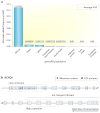Settling the score: variant prioritization and Mendelian disease
- PMID: 28804138
- PMCID: PMC5935497
- DOI: 10.1038/nrg.2017.52
Settling the score: variant prioritization and Mendelian disease
Abstract
When investigating Mendelian disease using exome or genome sequencing, distinguishing disease-causing genetic variants from the multitude of candidate variants is a complex, multidimensional task. Many prioritization tools and online interpretation resources exist, and professional organizations have offered clinical guidelines for review and return of prioritization results. In this Review, we describe the strengths and weaknesses of widely used computational approaches, explain their roles in the diagnostic and discovery process and discuss how they can inform (and misinform) expert reviewers. We place variant prioritization in the wider context of gene prioritization, burden testing and genotype-phenotype association, and we discuss opportunities and challenges introduced by whole-genome sequencing.
Conflict of interest statement
The authors declare competing interests: see Web version for details.
Figures



References
-
- Bamshad MJ, et al. Exome sequencing as a tool for Mendelian disease gene discovery. Nat Rev Genet. 2011;12:745–755. - PubMed
-
- The 1000 Genomes Project Consortium. A global reference for human genetic variation. Nature. 2015;526:68–74. By sequencing the genomes of more than 2,500 individuals from diverse world ancestries, this study provides the first genome-wide map of both common and rare human genetic variation. - PMC - PubMed
-
- Lek M, et al. Analysis of protein-coding genetic variation in 60,706 humans. Nature. 2016;536:285–291. The ExAC-integrated exome sequencing data from 60,706 individuals provides an invaluable reference data set of genetic variation in protein-coding genes. Assessing variant allele frequencies in ExAC facilitates the interpretation of candidate variants observed in Mendelian disease families. - PMC - PubMed
-
- Cooper GM, Shendure J. Needles in stacks of needles: finding disease-causal variants in a wealth of genomic data. Nat Rev Genet. 2011;12:628–640. - PubMed
Publication types
MeSH terms
Grants and funding
LinkOut - more resources
Full Text Sources
Other Literature Sources

